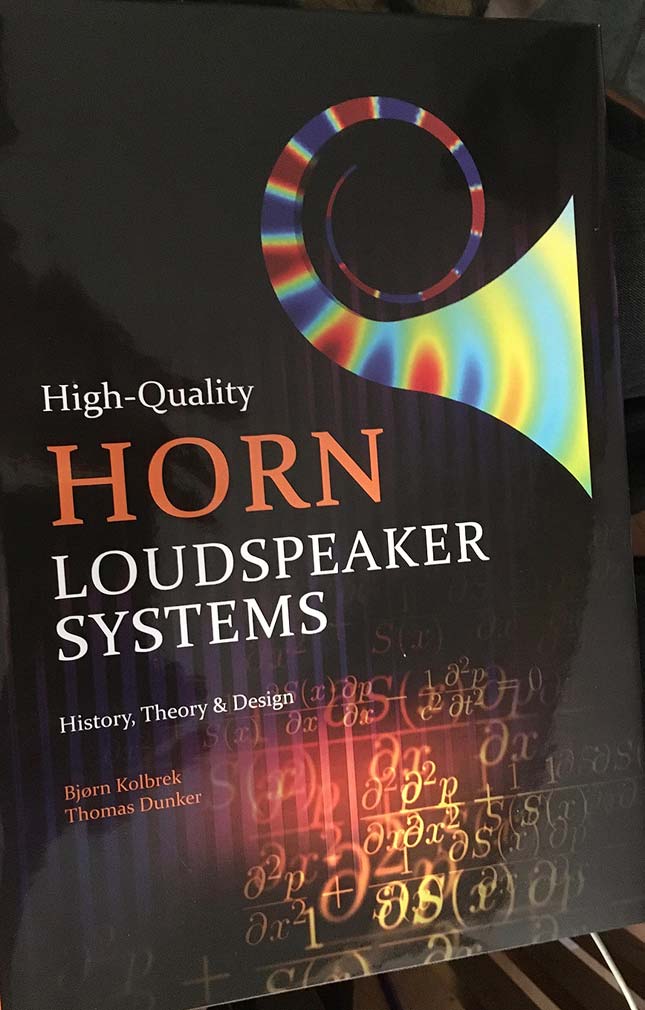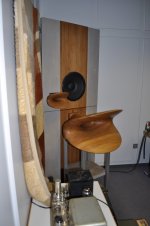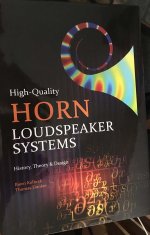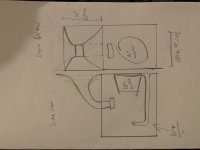Greetings all!
Im a broke 21 year old college student from Illinois and im usually active on the audio karma forums. I avoid posting here because the site to me is cluttered and confusing, however it seems there are more people on this website and more participation in the threads and just more in depth knowledge in general.
I am planning on getting a CNC mill soon and want to start making flat pack DIY kits for horns to sell to people, and would love to make some two way and three way systems, I just need to know where to start.
Im only 40% through with my degree in mechanical engineering, so my grasp and ability to understand papers and technical mumbo jumbo (which people have showed me and I have read) isn't that great. Its like a can partially grasp what I read on horn design but not fully.
The smartest people are really, the smart people who can explain things in a way easy enough for the common folk to understand it and im hoping one of you are good at this!
What is the best horn geometry? I realize that some horn types are better than others depending on the situation, and wanted to list all the pro's and cons of the different types fo horns.
Ive narrowed it down to 3 designs
can anyone give me a simplified explanation or list of the pro's and con's of
Tractrix horn
Bi-Radial Horn
Conical
any help??
Im a broke 21 year old college student from Illinois and im usually active on the audio karma forums. I avoid posting here because the site to me is cluttered and confusing, however it seems there are more people on this website and more participation in the threads and just more in depth knowledge in general.
I am planning on getting a CNC mill soon and want to start making flat pack DIY kits for horns to sell to people, and would love to make some two way and three way systems, I just need to know where to start.
Im only 40% through with my degree in mechanical engineering, so my grasp and ability to understand papers and technical mumbo jumbo (which people have showed me and I have read) isn't that great. Its like a can partially grasp what I read on horn design but not fully.
The smartest people are really, the smart people who can explain things in a way easy enough for the common folk to understand it and im hoping one of you are good at this!
What is the best horn geometry? I realize that some horn types are better than others depending on the situation, and wanted to list all the pro's and cons of the different types fo horns.
Ive narrowed it down to 3 designs
can anyone give me a simplified explanation or list of the pro's and con's of
Tractrix horn
Bi-Radial Horn
Conical
any help??
Its like a can partially grasp what I read on horn design but not fully.
The smartest people are really, the smart people who can explain things in a way easy enough for the common folk to understand it and im hoping one of you are good at this!
Really a deep subject. With so many potential compromises there at eno straightforward answers.
Aside: althou these are called horn systems, the horns usually cover less than half the spectrum and the most extended ones just reach into the middle of the midrange. I designed the bass/mid support for this system (up to 500 Hz). Te horn is based on the Yuchi.
What is the best horn geometry?
Very situational. If i was to dive into this again i would be looking at LeCleche flares, or Danley-like Synergies.
If your CNC is not 5-axis (4 might do) a CNC has limited use, but if it has a sufficient Z-axis range something like this is possible:

You build up 2 butcher blocks, carve the horn and outside shape and then flip one onto the other and glue them together.
Tractrix horn
Bi-Radial Horn
Conical
When i wen thru my HF horn period i used tractrix, Le' Cleche is sort of an evolution on that. The mid & top Horns at this ETF is an example:
Danley’s synergys are kind of boring (& conical), but solve the big issue of the (relatively) huge issues with C-C and the timing issues usually only solvable with DSP XOs.
dave
Attachments
Can't answer that straight. A horn is not a complex device, it is a complex set of complex devices with independent benefits.who can explain things in a way easy enough for the common folk to understand it and im hoping one of you are good at this!
What is the best horn geometry?
What do you want a horn to do, why do you want a horn?
What made you choose these three examples? They are each highly spoken of, but for three different reasons.Tractrix horn
Bi-Radial Horn
Conical
Just receive dthis book today. 1040 pages of 1st rate text book class.

Could well be a must have for anyonre looking at horns. So far just flippin gtheu the pictures i have only gotten to the posr WW2 era and pics of the 1st Altec 604.
dave
Could well be a must have for anyonre looking at horns. So far just flippin gtheu the pictures i have only gotten to the posr WW2 era and pics of the 1st Altec 604.
dave
Attachments
My goal is to first design a two way loudspeaker that can compete with the heresy and Cornwall. These speakers are somewhat limited by their size. I’d like to design a horn with a 90 degree bend but I’m not sure how it would affect the sound wave as it propagates through the horn.
I would like the horn to handle 400 or 500 hz to 20 kHz or thereabouts. I’ve seen some designs that can do this I’m just not sure which one to use. Here is a photo of what I’m thinking. It has a curved horn that starts in the woofer enclosure and juts out the top and bends 90 degrees. I want it to be on the larger side, and I could add a tweeter on top if necessary, but I’d like to keep it a two way.
Correct me if I’m wrong, but the throat diameter affects the high end losing right? A larger throat means it won’t be able to play as high? Is this feasible at all to design a horn that can cover this frequency range? Here is a photo of a quick drawing I made to show you what I’m thinking of.
I would like the horn to handle 400 or 500 hz to 20 kHz or thereabouts. I’ve seen some designs that can do this I’m just not sure which one to use. Here is a photo of what I’m thinking. It has a curved horn that starts in the woofer enclosure and juts out the top and bends 90 degrees. I want it to be on the larger side, and I could add a tweeter on top if necessary, but I’d like to keep it a two way.
Correct me if I’m wrong, but the throat diameter affects the high end losing right? A larger throat means it won’t be able to play as high? Is this feasible at all to design a horn that can cover this frequency range? Here is a photo of a quick drawing I made to show you what I’m thinking of.
Attachments
Last edited by a moderator:
Can't answer that straight. A horn is not a complex device, it is a complex set of complex devices with independent benefits.
What do you want a horn to do, why do you want a horn?
What made you choose these three examples? They are each highly spoken of, but for three different reasons.
My goal is high efficiency and decent coverage. I had klipsch la Scalas and they sounded pretty good wherever you are in the room and they “fill the room” with sound.
That still leaves you right in the middle of compromise land, so I'll ask you why not build something just like the la Scala mid horn. Does it suit your purpose, anything you don't like about it?
... a two way loudspeaker that can compete with the heresy and Cornwall…
Been a long time since i heard Cornwall, the Heresys i had sucked.
I would like the horn to handle 400 or 500 hz to 20 kHz or thereabouts.
Not likely gonna happen. A really good horn will do 3 1/2 maybe 4 octaves.
ie 400>800>1600>3200 Hz
or 500>1000>2000>4000
Above that it becomes a direct radiator
I’ve seen some designs that can do this
Are you sure they are not waveguides.
dave
The Cornscala type D from Crites has a fatial compression driver and what he advertises as a horn that plays 500 hz to 20 kHz.
The bi-radial horn on joesph Crowe’s website can play 500 hz to almost 20 kHz +\- 5 db
The bi-radial horn on joesph Crowe’s website can play 500 hz to almost 20 kHz +\- 5 db
+/- 5dB wow that is not good. I like the work Joseph has done, he has been at it for many years.
One of the issues with horns above a direct radiator is the large centre-to-centre (in an ideal world, less than a quarter wavelength at the XO point). Another issue is the different launch points, only fixable with a DSP XO with time delay well set.
One can minimize the issue of mid/top horn by designing the mid horn so that you can mount the tweteer inside that horn as part of a centre divider. Still need the DSP XO.
I would not put much stock in the Klipsch specs, they are pretty much written by the marketing deptarment.
And the stock Klipsch XOs cause huge problems with impedance, which is a big issue with high output impedance amplifiers (typically SE amps, the largest population of which are SETs). I know this does not have to be the case, someone pointed me at an aftermarket XO that acheived fairly flat impedance — but with REALLY steep roll-offs which further exacerbates the phase & timing issues.
I don’t want to discourage you, but there are big problems to overcome, and you have much to learn. Keep asking questions, then you have to make some stuff, and that will take some time — likely years, not months.
You need to read everything you can get your hand’s on and ask lots of questions.
All speakers are full of lots of compromises, the one thing that systems as you propose is dynamics. The efficiency advantage, if you don’t get the XO right is that most of the small amps want to look into a flat impedance curve.
Lots of peopel seen to enjoy their systems like this. I have yet to hear a good one, i would really like to.
And that brings XO issues. Passive XOs are hard. Harder than designing a horn IMO.
dave
One of the issues with horns above a direct radiator is the large centre-to-centre (in an ideal world, less than a quarter wavelength at the XO point). Another issue is the different launch points, only fixable with a DSP XO with time delay well set.
One can minimize the issue of mid/top horn by designing the mid horn so that you can mount the tweteer inside that horn as part of a centre divider. Still need the DSP XO.
I would not put much stock in the Klipsch specs, they are pretty much written by the marketing deptarment.
And the stock Klipsch XOs cause huge problems with impedance, which is a big issue with high output impedance amplifiers (typically SE amps, the largest population of which are SETs). I know this does not have to be the case, someone pointed me at an aftermarket XO that acheived fairly flat impedance — but with REALLY steep roll-offs which further exacerbates the phase & timing issues.
I don’t want to discourage you, but there are big problems to overcome, and you have much to learn. Keep asking questions, then you have to make some stuff, and that will take some time — likely years, not months.
You need to read everything you can get your hand’s on and ask lots of questions.
All speakers are full of lots of compromises, the one thing that systems as you propose is dynamics. The efficiency advantage, if you don’t get the XO right is that most of the small amps want to look into a flat impedance curve.
Lots of peopel seen to enjoy their systems like this. I have yet to hear a good one, i would really like to.
And that brings XO issues. Passive XOs are hard. Harder than designing a horn IMO.
dave
The Cornscala type D from Crites has a fatial compression driver and what he advertises as a horn that plays 500 hz to 20 kHz.
With EQ. If you look at the driver spec it falls some 10 dB from 5k (and is rough in the top octave), which is indicative that it is being unloaded above 5k (ie a direct radiator as i suggested).
dave
Just receive dthis book today. 1040 pages of 1st rate text book class.

Could well be a must have for anyonre looking at horns. So far just flippin gtheu the pictures i have only gotten to the posr WW2 era and pics of the 1st Altec 604.
dave
I got mine a few months ago. It is a fantastic resource, I cannot stress that enough. OP should seriously considering buying a copy. There is lots of math/science of horns in those pages.
I got mine a few months ago. It is a fantastic resource, I cannot stress that enough. OP should seriously considering buying a copy. There is lots of math/science of horns in those pages.
With EQ. If you look at the driver spec it falls some 10 dB from 5k (and is rough in the top octave), which is indicative that it is being unloaded above 5k (ie a direct radiator as i suggested).
dave
I will be getting the book when Iget some more cash coming in!
As far as my design goes, I am looking at this new driver Eminence has made.
Eminence N314X-8 Tour Grade 1.4" TeXtreme High-Frequency Compression Driver 8 Ohm 4-Bolt
it has a fancy new diaphragm and the frequency response is between 110 and 114 db from 1000 hz to 11 Khz! this is a crazy efficient driver and it seems like it would be the perfect driver for a two way system as it can play with 105 db sensitivity up to 20 kHz.
the impedance curve also looks very nice. it remains between 6.5 and 8 ohms from 800 h to 30 Khz.
now all this horn talk has me discouraged and confused. I see lots of eminence horns available that are advertised to play from 600 hz to 20 Khz. How can this be possible? everyone is telling me its not possible to have a horn that can play this wide of a bandwidth.
can anyone explain any of this to me in layman's terms. everyone keeps getting caught up on the definition of a horn vs a waveguide and I still have no real idea on the effects between different horn shapes on the frequency response or impedance loading of a driver. I need some real help here...
it has a fancy new diaphragm and the frequency response is between 110 and 114 db from 1000 hz to 11 Khz! this is a crazy efficient driver and it seems like it would be the perfect driver for a two way system as it can play with 105 db sensitivity up to 20 kHz.
Given that the woofer needs to be 3-4 dB for sensitive than the tweeter you will be throwing away more than 10dB of that.
the impedance curve also looks very nice. it remains between 6.5 and 8 ohms from 800 hz to 30 Khz.
What doe sit look like when you load it in your horn?
I see lots of eminence horns available that are advertised to play from 600 hz to 20 Khz. How can this be possible?
Marketing department and EQ, it will be a direct radiator at the highest frequencies. If you want a real horn that doe sthat you will need to look sat a Danley Synergy type horn (and pay royalties, i think he still has a valid patent on it.
...to have a horn that can play this wide of a bandwidth.
It will not be a horn at the highest frequencies.
… a horn vs a waveguide...
It is kinda squishy but basicaly a horn will increase efficiency, a waveguide controls the dispersion (so a shaped direct radiator, althou a waveguide, if big enuff does provide some loading at teh lowest frequencies to allow them to go lower than the driver would normally allow.
dave
Marketing department and EQ, it will be a direct radiator at the highest frequencies. If you want a real horn that doe sthat you will need to look sat a Danley Synergy type horn (and pay royalties, i think he still has a valid patent on it.
doesn't really have to be a synergy to get down to 600hz, if the question is about horn design then you just need size. getting the driver to play that low is another question. Also, you don't need to think about the patent unless you selling them. if you want to sell a design/speaker, then avoid the synergy patent and build a danley Unity horn (synergy patent covers a unique crossover I understand)
The 1st synergy’s went down to 300 Hz. The commercail ones go lower.
300 Hz is a nice XO point.
But what i was meaning is that being a 2-way (the horn) it can go all the way up, and it solve sthe phase/time issues inherent in a long mid horn+a much shorter tweeter with a passive XO.
dave
300 Hz is a nice XO point.
But what i was meaning is that being a 2-way (the horn) it can go all the way up, and it solve sthe phase/time issues inherent in a long mid horn+a much shorter tweeter with a passive XO.
dave
Just receive dthis book today. 1040 pages of 1st rate text book class.

Could well be a must have for anyonre looking at horns. So far just flippin gtheu the pictures i have only gotten to the posr WW2 era and pics of the 1st Altec 604.
dave
Who did you get the book through? I have been waiting for them to find a new North American merchant since they stopped selling through amazon.
I got it from the UK distributor Bjorn mentioned on the Joelist.
Had it shipped to Scott (Woden) so he would have an opportunity to read it before he sent it my way.
I am not a big fan of Amazon and i think they got a lot of similar feedback.
I expect they have had to do another print run. Are you on the JoeList? You could ask there.
dave
Had it shipped to Scott (Woden) so he would have an opportunity to read it before he sent it my way.
I am not a big fan of Amazon and i think they got a lot of similar feedback.
I expect they have had to do another print run. Are you on the JoeList? You could ask there.
dave
- Home
- Loudspeakers
- Multi-Way
- Horn design help me!!


